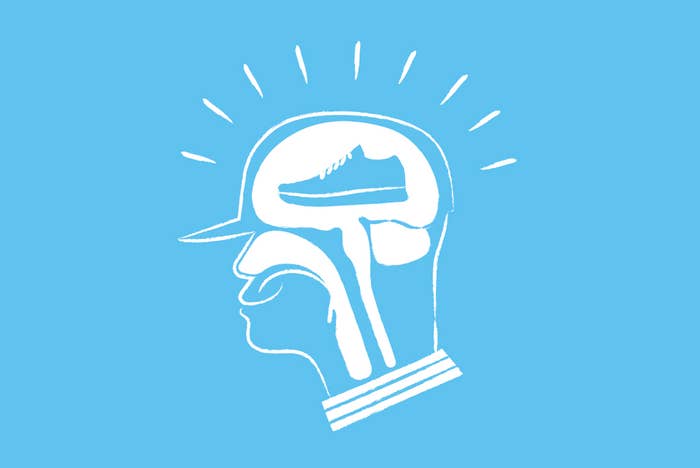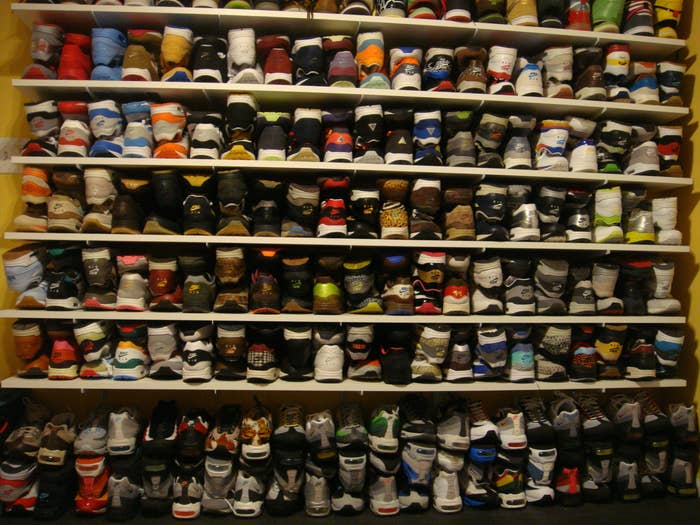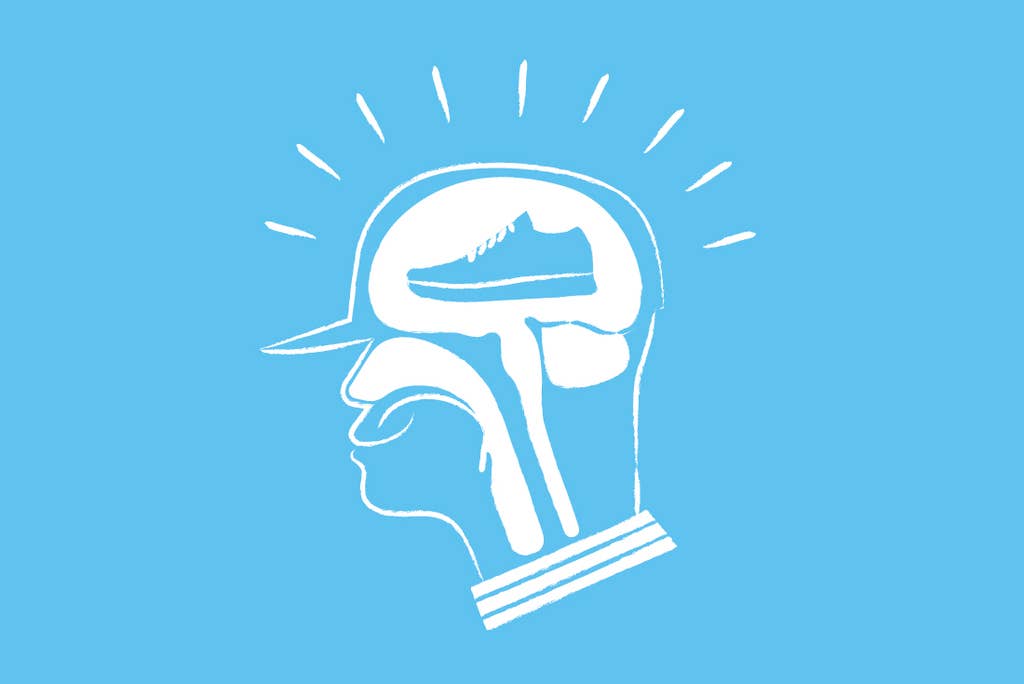
If you're on this site, there's more than a good chance that you know someone who owns 200-plus pairs of sneakers. It may be a person that you follow on Instagram; it may be the person you see in the mirror every morning. Some might even scoff at that number as mere child's play, and think that sneakerheads are not truly "'bout that life" unless their collection tips over into four-figure territory. Stacks on stacks on stacks, if you will.
Of course, all sneakerheads also have that friend or family member who thinks that owning anything more than a single pair of sneakers is excessive. "You only have two feet," they love to say (almost always while rocking a pair of Air Monarchs or Skechers). As annoying as that critique can be, self-reflective sneaker collectors have probably asked themselves at some point, "Do they have a point?"
It's common for sneakerheads to jokingly say, "It's a sickness," with a shrug, as they click "add to cart" early on a Saturday morning. While "obsessive sneaker disorder" may be a made-up diagnosis, anyone who has seen the TV show Hoarders understands what can happen when collecting goes bad. Saving every cardboard toilet paper roll ever used is clearly not a good look, but when you break it down, is it really that different from copping every pair of Yeezy Boost 350s that's ever dropped? Sure, many sneaker collectors maintain their shoes in immaculate condition and display them in custom-fitted spaces that are so pristine they resemble a clean room. But there are also plenty of sneakerheads with storage units who would be hard-pressed to identify, let alone get to, some of orange Nike and blue Adidas boxes stacked sloppily all the way up to the ceiling.
To get a better understanding of what motivates people to obsessively collect sneakers, we spoke with Dr. Michael Hickey, a clinical psychologist who is the director of the Center for Obsessive Compulsive and Related Disorders at the Albert Ellis Institute in New York, and Mark Pfeffer, a psychotherapist who is director of the Panic/Anxiety Recovery Center in Chicago and worked with patients on 20 episodes of Hoarders.

Why does it happen?
Let's clear something up right off the bat: There is nothing inherently bad about collecting sneakers. "Collecting can be a great thing. People have very large collections of a lot of different things and it's not problematic for them," says Dr. Hickey. But there are those who develop an over-attachment to items such as sneakers. There are no blanket causes for this; it varies on a case-by-case basis. "Nobody really knows why people have certain obsessions and compulsions," says Pfeffer. But among people who deal with obsessive-compulsive disorder (OCD) and social-anxiety disorder, which can be hereditary, certain trends start to emerge.
Control is usually a big issue. The patient thinks, "At some point there's actually going to be some function for this. It may not be right now, I may not be able to tell you exactly when it's going to be, but whether it be for fashion or for purpose there may be a day or a time that I need this," says Dr. Hickey. "There's usually an overestimate of that need."
This can be especially true of sneakers, where a particular colorway that is releasing may not link up with a 'fit currently in your closet, but you buy the shoes anyway because you convince yourself that you'll pick up the clothes to match in the future. Or maybe a pair of triple-white kicks drops in the dead of winter, and you purchase them because you swear you'll rock them come summer. If these predictions turn into reality, there usually isn't an issue. But if a person overestimates these imagined scenarios and if he or she becomes very uncomfortable without having a certain item, then it can become problematic.
"You can post pics of your sneaker collection on Instagram and watch the likes roll in instantly."
Sneakers "hold a particular cachet," according to Pfeffer. His clients with social anxiety, which is the exquisite sensitivity to scrutiny from others, "will say they're always worried about people checking them out." Since sneakers are one of the key ways that individuals distinguish themselves with their attire, they can become an important focal point.
And if that focus is rewarded with positive feedback, a cycle can develop. Let's say someone buys a new pair of sneakers and receives compliments about them. For certain individuals, according to Dr. Hickey, that can lead them to think, "Well, if I did this one time and I got positive reinforcement, then why not do it again and again?"
That gets amplified in the social media age. It used to be that the only way to show off an impressive collection was to have people visit in person. Now, when you can post pics of your sneaker collection on Instagram and watch the likes roll in instantly, the appeal becomes even more compelling. "The more immediate reinforcement is, the stronger it is," Dr. Hickey says. "And if someone has not been been reinforced for other qualities, then all of a sudden, [he becomes] the guy with all these different sneakers. [Someone could] possibly attach one's worth to it."

When does it become a problem?
"If someone is collecting things and they have their set time during the day...and it's not totally taking over their lives to the point where it's affecting their work or their socializing, then good for them," says Dr. Hickey. It's when an endeavor like sneaker collecting starts to negatively impact other aspects of a person's life that problems can arise.
There is no clinical line that divides collecting from hoarding, but the level of organization can often be a sign. "Usually, with healthy collecting, the individual's possessions are well organized," says Dr. Hickey. Individuals who might have an issue, according to Pfeffer, "just have stuff in boxes thrown around thrown and are running to the next find without even taking care of [their existing] collection."
The obsession can be a way of avoiding other issues. "They don't want to think. So what's the best way to do it? I'll just go searching for more stuff. If you're really a serious collector or hoarder of sneakers, it can be a full-time job," says Pfeffer.
"It's when an endeavor like sneaker collecting starts to negatively impact other aspects of a person's life that problems can arise."
When that occurs, it can start to negatively impact a person's functioning. For starters, there are the physical hazards. The idea of someone being buried under an avalanche of sneakers may seem like a joke, but if someone has boxes filling every crevice of their home, there can be a very real danger. Then there are the financial concerns. Sneakers, especially those prized by collectors, aren't cheap. If someone is racking up massive credit card debt to buy new kicks, that can be another warning sign. Relationships can also suffer as a result of obsessive sneaker purchases.
These are the things that psychologists look for when they try to determine if a patient has a problem. It isn't a diagnosis based on number. Someone can have 2,000 pairs of sneakers and have a perfectly healthy relationship with their collection, and someone can have 20 pairs and have an unhealthy relationship with them.
What can be done to fix it?
The standard for treating disorders of this type is called cognitive behavioral therapy. Rather than the dimestore Hollywood-version of therapy, which traces everything back to childhood issues, cognitive behavioral therapy deals with the here and now. The treatment involves first identifying any maladaptive or irrational beliefs that a patient might have, such as a person thinking their self worth is connected to their sneaker collection or that they won't be able to cope if they don't have have all of the items. Then the therapy shifts to helping patients think differently about their beliefs. As Pfeffer puts it, "Just because I think it doesn't mean it's true."
From there, it moves on to systematically exposing patients to potentially problematic situations. It may start with helping someone identify sneakers they can get rid of and learning to be comfortable with that or having someone visit a sneaker store and not purchase anything. For people who don't have problems with sneaker collecting, these scenarios may seem trivial or easy. But for those who suffer from these disorders, it can be a very difficult process.
The upside is that once they start to see positive consequences come from their new behavior it can reinforce that behavior and help people hopefully develop a healthy relationship with sneakers again.

